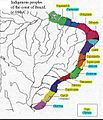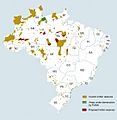Indigenous peoples in Brazil facts for kids
| Total population | |
|---|---|
| 996,917 0.6% of Brazil's population |
|
| Regions with significant populations | |
| Predominantly in the North and Central-West | |
| Languages | |
| Indigenous languages, Portuguese | |
| Religion | |
| Originally traditional beliefs and animism. 61.1% Roman Catholic, 19.9% Protestant, 11% non-religious, 8% other beliefs. Animist religions still widely practiced by isolated populations | |
| Related ethnic groups | |
| Other indigenous peoples of the Americas |
Indigenous peoples in Brazil (Portuguese: povos indígenas no Brasil) or Indigenous Brazilians (Portuguese: indígenas brasileiros) once comprised an estimated 2000 tribes and nations inhabiting what is now the country of Brazil, prior to the European contact around 1500. Christopher Columbus thought he had reached the East Indies, but Portuguese Vasco da Gama had already reached India via the Indian Ocean route, when Brazil was invaded by Portugal. Nevertheless, the word índios ("Indians") was by then established to designate the people of the New World and continues to be used in the Portuguese language to designate these people, while a person from India is called indiano in order to distinguish the two.
At the time of European contact, some of the Indigenous people were traditionally semi-nomadic tribes who subsisted on hunting, fishing, gathering and migrant agriculture. Many tribes suffered extinction as a consequence of the European settlement and many were assimilated into the Brazilian population.
The Indigenous population was decimated by European diseases, declining from a pre-Columbian high of 2 to 3 million to some 300,000 as of 1997[update], distributed among 200 tribes. By the 2010 IBGE census, 817,000 Brazilians classified themselves as Indigenous. A 1985 linguistic survey found 188 living indigenous languages with 155,000 total speakers.
On January 18, 2007, FUNAI reported 67 remaining uncontacted tribes in Brazil, up from 40 known in 2005. With this addition Brazil passed New Guinea, becoming the country with the largest number of uncontacted peoples in the world.
Images for kids
-
Apiacá people, painted by Hércules Florence, 1827
-
Marshal Cândido Rondon.
-
Members of an uncontacted tribe encountered in the Brazilian state of Acre in 2009
-
Fulni-ô representative talks about the culture of his people to schoolchildren in the Botanical Garden of Brasilia, in celebration of Indian Day, 2011
See also
 In Spanish: Pueblos indígenas de Brasil para niños
In Spanish: Pueblos indígenas de Brasil para niños




















